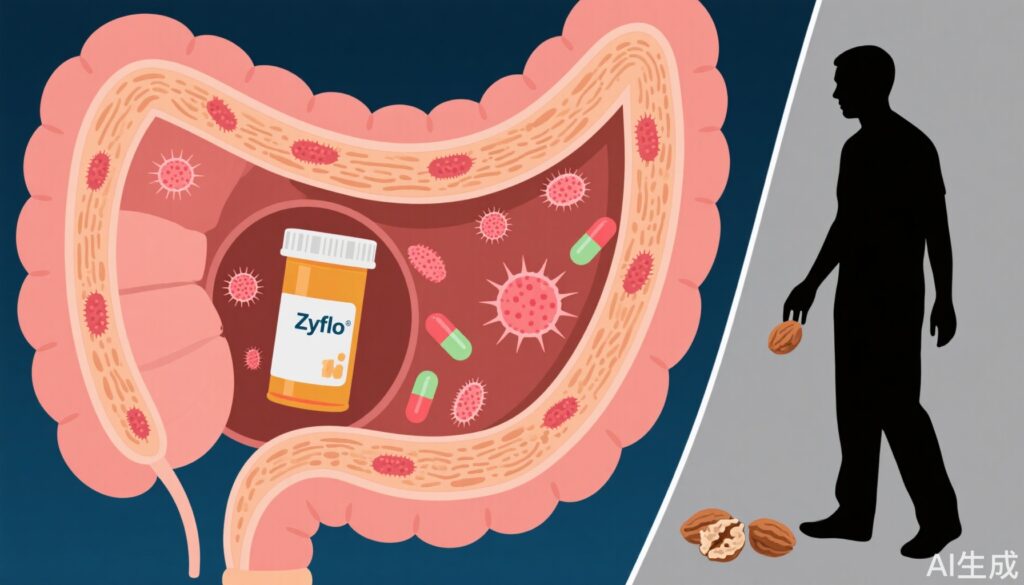Background: why food allergy remains a global concern
Food allergy occurs when the immune system mounts an exaggerated response to proteins in food. In its most severe form this reaction can progress to anaphylaxis, a rapid and potentially fatal syndrome featuring airway constriction, low blood pressure, and multi-system collapse. Clinically important food allergies affect millions worldwide and have been increasing in prevalence for decades. In the United States alone an estimated 33 million people have at least one food allergy, roughly one in ten in some age groups.
Mechanistically, many immediate food allergic reactions are driven by immunoglobulin E antibodies (IgE). IgE bound to high-affinity receptors on mast cells recognizes specific food allergens and triggers mast cell activation and mediator release. Mast cell mediators include histamine, proteases, and lipid mediators such as leukotrienes. Until now, much of our mechanistic understanding derived from experimental models in which allergens are injected under the skin or intravenously, a route that simulates systemic exposure but not the common real-world route of eating the offending food. How ingestion of an allergen leads to a catastrophic systemic response has been incompletely understood.
Key findings from the new studies
Two back-to-back studies published in Science provide important advances in this area. Working in mice, the teams identified a leukotriene-driven pathway that promotes absorption of food allergens across the gut and showed that genetic variation in an enzyme called DPEP1 modifies susceptibility to oral anaphylaxis. The second group demonstrated that blocking leukotriene synthesis with the FDA‑approved asthma drug Zileuton dramatically reduced, and in most cases prevented, lethal anaphylaxis triggered by ingested allergens in mice.
These papers therefore link three pieces of the puzzle: (1) mucosal mast cells in the gut generate cysteinyl leukotrienes (CysLTs) in response to allergen; (2) elevated CysLTs increase allergen absorption from the gut lumen into tissues and circulation; and (3) genetic differences in DPEP1 influence levels of a specific leukotriene, thereby changing an individual animal’s risk of developing anaphylactic shock after eating an allergen.
What are leukotrienes and why do they matter?
Leukotrienes are inflammatory lipid mediators produced from arachidonic acid via the enzyme 5‑lipoxygenase and downstream enzymes. There are several types: LTB4 and the cysteinyl leukotrienes LTC4, LTD4, and LTE4. Cysteinyl leukotrienes are potent regulators of vascular permeability, smooth muscle contraction, and mucosal function. They are well known in asthma biology for bronchoconstriction and airway inflammation.
The new work emphasizes a different role: in the gut, CysLTs produced by mucosal mast cells increase the movement of allergen particles or solutes across the epithelial barrier into the lamina propria and beyond. In effect, these lipid mediators amplify the amount of allergen that reaches systemic immune effector cells, thereby increasing the likelihood and severity of anaphylaxis when allergens are ingested.
DPEP1 gene variation and susceptibility to oral anaphylaxis
DPEP1 is a membrane-associated dipeptidase expressed in several tissues including the intestine. The studies found that different variants of the DPEP1 protein differ in their ability to degrade LTD4. In mouse strains that resist oral anaphylaxis, DPEP1 variants were more active and cleared LTD4 more effectively, lowering local CysLT levels and reducing allergen absorption. By contrast, susceptible strains carried DPEP1 variants with lower enzymatic activity, allowing LTD4 to accumulate and facilitate allergen entry into tissues.
This result is important for two reasons. First, it helps explain why animals (and potentially humans) with similar levels of allergen-specific IgE may nonetheless differ in clinical outcomes after ingestion. Second, it raises the possibility that human genetic variation in DPEP1 or related pathways could someday help stratify risk for severe food reactions, though confirmation in people is required.
Zileuton (Zyflo): a repurposed drug that blocks leukotriene synthesis
Zileuton is a small-molecule inhibitor of 5‑lipoxygenase, the enzyme that initiates leukotriene synthesis. Marketed in the United States as Zyflo, it is approved for the long-term management of asthma in selected patients. Zileuton reduces production of both LTB4 and cysteinyl leukotrienes.
In the mouse studies, pretreatment with Zileuton substantially reduced or prevented anaphylactic shock following oral exposure to food allergens. Impressively, treated mice went from roughly a 95% risk of severe reaction to about a 95% protection rate in the experimental settings used. Notably, Zileuton did not protect mice from anaphylaxis induced by systemic (parenteral) exposure to allergen, which is consistent with the mechanism being specific to leukotrienes that act on gut mucosal physiology.
These findings suggest a potential new preventive strategy: administering a short course of a leukotriene synthesis blocker before anticipated allergen exposure (for example, before a meal with uncertain ingredients, social events, or travel) might reduce the chance that accidental ingestion leads to severe anaphylaxis. Because Zileuton is orally available and already FDA‑approved for another indication, it is an attractive candidate for rapid clinical translation. The research teams have initiated early human safety and proof-of-concept trials to test whether the mouse results translate to people.
Clinical context, safety considerations, and limitations
While the preclinical data are compelling, several important caveats require emphasis before clinical application:
– Species differences: Mouse gut physiology and immune responses differ from humans. Positive animal data are necessary but not sufficient to predict efficacy in people.
– Route-specificity: The protective effect of leukotriene blockade in these studies was specific to orally induced anaphylaxis and did not extend to systemic allergen exposure. Zileuton would not replace epinephrine or other emergency measures for treating anaphylaxis once it has started.
– Drug safety: Zileuton can cause elevations in liver transaminases and has been associated with rare cases of clinically apparent liver injury. When used chronically in asthma, regular liver function monitoring is recommended. Short-term, episodic use prior to meals may have a different safety profile, but this must be formally tested in clinical trials.
– Dose and timing: Effective dosing and timing for pre-exposure prophylaxis in humans are unknown. Trials will need to determine when to give the drug relative to eating, how long protection lasts, and whether repeated dosing is safe.
– Heterogeneous mechanisms: Not all food allergy reactions may depend primarily on leukotriene-mediated increased absorption. Some reactions could be dominated by histamine or other mediators released by connective tissue mast cells in non-mucosal tissues.
Implications for patients and clinicians
For patients and families living with food allergy, these studies are encouraging because they identify a previously underappreciated mechanism and a concrete drug candidate to test. However, practical recommendations remain unchanged for now: continue strict allergen avoidance as advised, carry epinephrine auto-injectors when indicated, and follow individualized management plans from allergy specialists.
Clinicians should watch for results from ongoing human trials. If Zileuton or similar leukotriene synthesis inhibitors demonstrate safety and efficacy as short-term pre-exposure prophylaxis, they could become a tool for reducing risk in high‑risk situations, complementing rather than replacing current treatments such as epinephrine and immunotherapies.
Future directions
Next steps include validating the DPEP1 findings in human cohorts, completing randomized clinical trials of Zileuton for prevention of food-induced anaphylaxis, and exploring combination strategies. For example, pairing transient leukotriene blockade with desensitization therapies such as FDA‑approved peanut oral immunotherapy (Palforzia) or monoclonal anti-IgE therapy (omalizumab, trade name Xolair) may provide synergistic benefit in some patients.
Longer term, genetic or biomarker panels that include DPEP1 activity could aid risk stratification, helping clinicians identify patients most likely to benefit from targeted prophylaxis.
Conclusion
The two Science reports significantly advance our understanding of how ingested allergens can trigger systemic anaphylaxis. By identifying mucosal leukotrienes and DPEP1 variation as key determinants of allergen absorption and severity, and by showing that pharmacologic leukotriene blockade prevents oral anaphylaxis in mice, these studies open a plausible path toward new preventive strategies in humans. Careful clinical trials will be required to confirm safety and efficacy, but the work offers real hope for additional tools to protect people with life‑threatening food allergies.
References cited in the original reports include the two Science articles by Hoyt et al and Bachtel et al and related news releases summarizing the findings and the Zileuton data.
References
[1] Laura R. Hoyt et al. ,Cysteinyl leukotrienes stimulate gut absorption of food allergens to promote anaphylaxis in mice.Science389,eadp0240(2025).DOI:10.1126/science.adp0240 IF: 45.8 Q1 [2] Nathaniel D. Bachtel et al. ,Intestinal mast cell–derived leukotrienes mediate the anaphylactic response to ingested antigens.Science389,eadp0246(2025).DOI:10.1126/science.adp0246 IF: 45.8 Q1 [3] What drives anaphylactic response in food allergies. Retrieved August 8, 2025 from https://www.eurekalert.org/news-releases/1093492
[4] Asthma drug Zileuton blocks food allergy reactions in mice. Retrieved August 8, 2025 from https://www.eurekalert.org/news-releases/1092951


